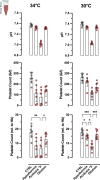Histone-driven hypercoagulation contributes to the lethal triad of acute trauma-induced coagulopathy
- PMID: 40830357
- PMCID: PMC12365074
- DOI: 10.1038/s41598-025-12431-7
Histone-driven hypercoagulation contributes to the lethal triad of acute trauma-induced coagulopathy
Abstract
Severe tissue injury and hemorrhagic shock can result in trauma-induced coagulopathy (TIC), acidosis, and hypothermia, denoted as lethal triad. This condition exacerbates trauma complications and contributes to organ dysfunction and mortality, prompting the need to better define its complex pathomechanisms in the blood. Therefore, we developed a standardized ex vivo human whole blood (hWB) model to differentiate the impact of various pathophysiological conditions, damage-associated molecular patterns (DAMPs), and key inflammatory mediators on TIC development. Modelling incremental grades of the lethal triad, we assessed the resulting thrombo-coagulopathy by monitoring platelet activation, clot formation, and mediator release. Both acidosis and hypothermia independently triggered platelet activation (with enhanced surface CD62P/CD63 expression) and platelet consumption, leading to ex vivo clot formation. Completing the lethal triad with additional dilutional coagulopathy revealed even more pronounced effects. Further dissecting underlying cross-talk mechanisms, platelet-rich plasma (PRP) or isolated platelets exposed to similar conditions exhibited no relevant impact on platelet function. Notably, histones-unlike HMGB1, pro-inflammatory cytokines or anaphylatoxins-amplified the lethal triad-driven hypercoagulative TIC response in both hWB and PRP. In conclusion, our findings in a modular, clinically relevant whole blood model highlight histones as a central driver of TIC. Furthermore, tracking early TIC progression in this model provides an effective and efficient platform for evaluating novel therapeutic approaches to target drivers of coagulopathy.
Keywords: Coagulopathy; Hemostasis; Platelets; TIC; Trauma.
© 2025. The Author(s).
Conflict of interest statement
Declarations. Competing interests: The authors declare no competing interests.
Figures




References
-
- Mitrophanov, A. Y., Szlam, F., Sniecinski, R. M., Levy, J. H. & Reifman, J. Controlled multifactorial coagulopathy: effects of dilution, hypothermia, and acidosis on thrombin generation in vitro. Anesth. Analg. 130 (4), 1063–1076 (2020). - PubMed
-
- Mitrophanov, A. Y. et al. Injury length and arteriole constriction shape clot growth and Blood-Flow acceleration in a mouse model of thrombosis. Arterioscler. Thromb. Vasc Biol.40 (9), 2114–2126 (2020). - PubMed
-
- Balmer, J. C. et al. Continued relevance of initial temperature measurement in trauma patients. Am. Surg.88 (3), 424–428 (2022). - PubMed
MeSH terms
Substances
LinkOut - more resources
Full Text Sources
Medical
Research Materials
Miscellaneous

